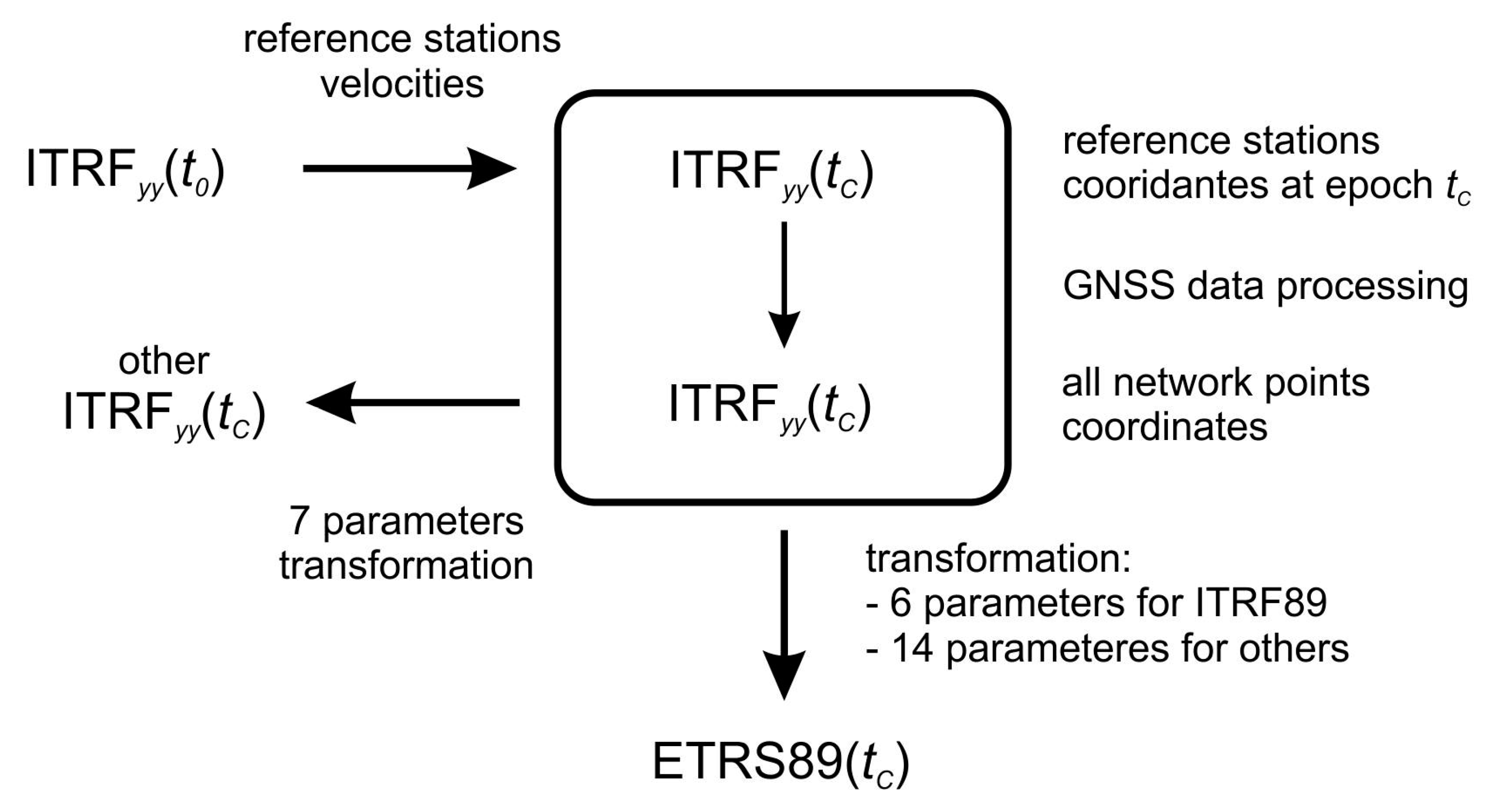Crustal Deformation Across and beyond Central Europe and Its Impact on Land Boundaries
Abstract
:1. Introduction
2. Background
3. Methods
- GNSS solutions of the selected points are processed in ITRFyy (e.g., ITRF2014) and transformed to the target ETRS89 reference frame, the ETRFyy (e.g., ETRF2014), corresponding to the ITRFyy. Calculations are made by a simple formula:and for the velocities:where and refer to station positions and velocities, respectively, and the indexes and represent the systems ITRS and ETRS89, respectively. The rotation rate parameters are expressed in the ITRFyy and translation vector is the global offset between ITRF versions. The rotation and translation values are available in the literature [39].
- GNSS solutions are processed in ITRFyy (e.g., ITRF2008) and the target ETRS89 reference frame is ETRFxx (e.g., ETRF2000), which do not correspond to the ITRFyy. Calculations are made in two steps: transforming coordinates at the epoch from ITRFyy into ITRFxx using Equation (1) and from epoch to epoch . The second step is similar to Point 1, by using Equations (3) and (4).
4. Results
- Direct field measurements
- Photogrammetric measurements
- Carthometric measurements
5. Discussion and Conclusions
Author Contributions
Funding
Institutional Review Board Statement
Informed Consent Statement
Data Availability Statement
Conflicts of Interest
References
- Williamson, I.; Enemark, S.; Wallace, J.; Rajabifard, A. Land Administration for Sustainable Development; ESRI Press Academic: Redlands, CA, USA, 2010; ISBN 9781589480414. [Google Scholar]
- Navratil, G.; Feucht, R. An example for a comprehensive quality description the area in the Austrian cadastre. In Spatial Data Quality; CRC Press: Boca Raton, FA, USA, 2009; pp. 197–209. [Google Scholar]
- Hanus, P.; Jasińska, E.; Preweda, E. Analysis of the accuracy of determining the coordinates property borders. In Proceedings of the 9th International Conference “Environmental Engineering 2014”; Vilnius Gediminas Technical University Press “Technika” 2014: Vilnius, Lithuania, 2014. [Google Scholar]
- Hanus, P.; Benduch, P.; Pęska-Siwik, A.; Szewczyk, R. Three-stage assessment of parcel area quality. Area 2020, 1–14. [Google Scholar] [CrossRef]
- Benduch, P. The Assessment of the influence of average errors of parcels’ surface areas on the final result of land properties’ valuation process. Geomat. Environ. Eng. 2016, 10, 27–38. [Google Scholar] [CrossRef] [Green Version]
- Williamson, I.P. Land administration “best practice” providing the infrastructure for land policy implementation. Land Use Policy 2001, 18, 297–307. [Google Scholar] [CrossRef] [Green Version]
- Shah, M.; Jin, S. Pre-seismic ionospheric anomalies of the 2013 Mw = 7.7 Pakistan earthquake from GPS and COSMIC observations. Geod. Geodyn. 2018, 9, 378–387. [Google Scholar] [CrossRef]
- Kozioł, K.; Maciuk, K. New heights of the highest peaks of Polish mountain ranges. Remote Sens. 2020, 12, 1446. [Google Scholar] [CrossRef]
- Hanus, P.; Pęska-Siwik, A.; Benduch, P.; Szewczyk, R. Comprehensive assessment of the quality of spatial data in records of parcel boundaries. Meas. J. Int. Meas. Confed. 2020, 158. [Google Scholar] [CrossRef]
- Craig, B.A.; Wahl, J.L. Cadastral survey accuracy, standards. Surv. L. Inf. Sci. 2003, 63, 87–106. [Google Scholar]
- van der Molen, P.; Lemmen, C.; Jan Wakker, W.; Lemmen, C. Land Registration and Cadastre in the Netherlands, and The Role of Cadastral Boundaries: The Application of GPS Technology in the Survey of Cadastral Boundaries. J. Geosp. Eng. 2003, 5, 3–10. [Google Scholar]
- Van Oosterom, P.J.M.; Lemmen, C.H.J.; Uitermark, H.T.; Boekelo, G.; Verkuijl, G. Land administration standardization with focus on surveying and spatial representations. Proc. ACMS Annu. Conf. Surv. Summit 2011, 28. Available online: https://repository.tudelft.nl/islandora/object/uuid:904b4af6-f67e-4abc-80d5-bd649a7134bb/datastream/OBJ/download (accessed on 30 July 2020).
- Benduch, P.; Peska, A. Comparison of the Methods of Capturing Data Concerning Parcel Boundaries in Aspects of their Accuracy and Reliability. In Proceedings of the International Geographic Information Systems Conference and Exhibition “GIS ODYSSEY 2016”, Perugia, Italy, 5–9 September 2016; pp. 25–34. [Google Scholar]
- Mallard, C.; Coltice, N.; Seton, M.; Müller, R.D.; Tackley, P.J. Subduction controls the distribution and fragmentation of Earth’s tectonic plates. Nature 2016, 535, 140–143. [Google Scholar] [CrossRef] [Green Version]
- Spence, W. Slab pull and the seismotectonics of subducting lithosphere. Rev. Geophys. 1987, 25, 55. [Google Scholar] [CrossRef] [Green Version]
- Conrad, C.P.; Lithgow-Bertelloni, C. How mantle slabs drive plate tectonics. Science 2002, 298, 207–209. [Google Scholar] [CrossRef] [PubMed]
- Segev, A. Flood basalts, continental breakup and the dispersal of Gondwana: Evidence for periodic migration of upwelling mantle flows (plumes). Stephan Mueller Spec. Publ. Ser. 2002, 2, 171–191. [Google Scholar] [CrossRef]
- Guzy, A.; Malinowska, A.A. State of the art and recent advancements in the modelling of land subsidence induced by groundwater withdrawal. Water 2020, 12, 51. [Google Scholar] [CrossRef]
- Ostřihanský, L. Causes of earthquakes and lithospheric plates movement. Solid Earth Discuss. 2012, 4, 1411–1483. [Google Scholar] [CrossRef] [Green Version]
- Nordman, M.; Peltola, A.; Bilker-Koivula, M.; Lahtinen, S. Past and Future Sea Level Changes and Land Uplift in the Baltic Sea Seen by Geodetic Observations. In International Association of Geodesy Symposia; Springer: Berlin, Heidelberg, 2020. [Google Scholar]
- Madsen, K.S.; Høyer, J.L.; Suursaar, Ü.; She, J.; Knudsen, P. Sea level trends and variability of the Baltic Sea from 2D statistical reconstruction and altimetry. Front. Earth Sci. 2019, 7, 1–12. [Google Scholar] [CrossRef]
- Łyszkowicz, A.; Bernatowicz, A. Geocentric Baltic Sea level changes along the southern coastline. Adv. Sp. Res. 2019, 64, 1807–1815. [Google Scholar] [CrossRef]
- E.U. Copernicus Marine Service Information Time Series of Mean Sea Level Trends over Global Ocean. Available online: https://marine.copernicus.eu/access-data/ocean-monitoring-indicators/time-series-mean-sea-level-trends-over-global-ocean (accessed on 30 July 2020).
- Boucher, C. Terrestrial Coordinate Systems and Frames. In The Encyclopedia of Astronomy and Astrophysics; IOP Publishing Ltd.: Bristol, UK, 2001. [Google Scholar]
- Mueller, I.I. Conventional Terrestrial Reference Frames. J. Geod. 2011, 21, 163–169. [Google Scholar]
- IUGG. International Union of Geodesy and Geophysics (IUGG) Resolution Number 2 of Perugia; Bureau International des Poids et Mesures Sevres: Breteuil, France, 2007. [Google Scholar]
- Petit, G.; Luzum, B. IERS Conventions (IERS Technical Note No. 36); Bureau International des Poids et Mesures Sevres: Breteuil, France, 2010; p. 179. [Google Scholar]
- Altamimi, Z.; Collilieux, X.; Métivier, L. ITRF2008: An improved solution of the international terrestrial reference frame. J. Geod. 2011, 85, 457–473. [Google Scholar] [CrossRef] [Green Version]
- Altamimi, Z.; Rebischung, P.; Métivier, L.; Collilieux, X. ITRF2014: A new release of the International Terrestrial Reference Frame modeling nonlinear station motions. J. Geophys. Res. Solid Earth 2016, 121, 6109–6131. [Google Scholar] [CrossRef] [Green Version]
- Kouba, J.; Popelar, J. Modern geodetic reference frames for precise satellite positioning and navigation. In International Symposium on Kinematic Systems in Geodesy, Geomatics & Navigation (KIS 94); Department of Geomatics Engineering, University of Calgary: Calgary, AB, Canada, 1994; pp. 79–85. [Google Scholar]
- Feissel-Vernier, M.; de Viron, O.; Le Bail, K. Stability of VLBI, SLR, DORIS, and GPS positioning. Earth Planets Space 2007, 59, 475–497. [Google Scholar] [CrossRef] [Green Version]
- Altamimi, Z.; Rebischung, P.; Métivier, L.; Collilieux, X. The International Terrestrial Reference Frame: Lessons from ITRF2014. Rend. Lincei. Sci. Fis. Nat. 2018, 29, 23–28. [Google Scholar] [CrossRef]
- Cai, J. The systematic analysis of the transformation between the German geodetic reference system (DHDN, DHHN) and the ETRF system (DREF91). Earth Planets Space 2000, 52, 947–952. [Google Scholar] [CrossRef] [Green Version]
- Boucher, C.; Altamimi, Z. Memo: Specifications for Refer-Ence Frame Fixing in the Analysis of a EUREF GPS Campaign 2011, 9. Available online: http://users.auth.gr/kvek/20070327-MEMO-ver6.pdf (accessed on 30 July 2020).
- Zhu, W.; Song, S.; He, L. Recommendations for construction of a nonlinear international Terrestrial Reference Frame. Sci. China Phys. Mech. Astron. 2011, 54, 164–171. [Google Scholar] [CrossRef]
- Rabah, M.; Elmewafey, M.; Farahan, M.H. Datum maintenance of the main Egyptian geodetic control networks by utilizing Precise Point Positioning “PPP” technique. NRIAG J. Astron. Geophys. 2016, 5, 96–105. [Google Scholar] [CrossRef]
- Ze, Z.; Guojie, M.; Xiaoning, S.; Jicang, W.; Xiaojing, L.J. Global crustal movement and tectonic plate boundary deformation constrained by the ITRF2008. Geod. Geodyn. 2015, 3, 40–45. [Google Scholar] [CrossRef] [Green Version]
- Royal Observatory of Belgium Map of EPN Station Positions & Velocities. Available online: http://www.epncb.oma.be/_productsservices/coordinates/posvel_map.php (accessed on 30 July 2020).
- Altamimi, Z. EUREF Technical Note 1: Relationship and Transformation between the International and the European Terrestrial Reference Systems. Available online: http://etrs89.ensg.ign.fr/pub/EUREF-TN-1.pdf (accessed on 30 July 2020).
- Bosy, J. Global, regional and national geodetic reference frames for geodesy and geodynamics. Pure Appl. Geophys. 2014, 171, 783–808. [Google Scholar] [CrossRef] [Green Version]
- Royal Observatory of Belgium Positions & Velocities. Available online: http://www.epncb.oma.be/_productsservices/coordinates/ (accessed on 6 August 2020).
- Henriksen, H. The role of some regional factors in the assessment of well yields from hard-rock aquifers of Fennoscandia. Hydrogeol. J. 2003, 11, 628–645. [Google Scholar] [CrossRef]
- Bogdanov, V.I. Generalization of hypothesis on nature of the Fennoscandia postglacial uplift phenomenon. Dokl. Earth Sci. 2010, 433, 911–914. [Google Scholar] [CrossRef]
- Groves, P.D. Principles of GNSS, inertial, and multisensor integrated navigation systems. In Artech House, 2nd ed.; IEEE: New York, NY, USA, 2013; p. 776. [Google Scholar]
- Li, X.; Ge, M.; Dai, X.; Ren, X.; Fritsche, M.; Wickert, J.; Schuh, H. Accuracy and reliability of multi-GNSS real-time precise positioning: GPS, GLONASS, BeiDou, and Galileo. J. Geod. 2015, 89, 607–635. [Google Scholar] [CrossRef]
- Sztwiertnia, D.; Ochałek, A.; Tama, A.; Lewińska, P. HBIM (Heritage Building Information Model) of the Wang Stave church in Karpacz—Case study. Int. J. Archit. Herit. 2019, 1–15. [Google Scholar] [CrossRef]
- Kampczyk, A. Magnetic-measuring square in the measurement of the circular curve of rail transport tracks. Sensors 2020, 20, 560. [Google Scholar] [CrossRef] [PubMed] [Green Version]
- Kampczyk, A. Measurement of the geometric center of a turnout for the safety of railway infrastructure using mms and total station. Sensors 2020, 20, 4467. [Google Scholar] [CrossRef] [PubMed]
- Bischoff, M.; Cete, A.; Fritschen, R.; Meier, T. Coal mining induced seismicity in the Ruhr Area, Germany. Pure Appl. Geophys. 2010, 167, 63–75. [Google Scholar] [CrossRef]
- OpenStreetMap Contributors OpenStreetMap. Available online: https://www.openstreetmap.org (accessed on 25 January 2021).
- Polish Geological Institute National Research Institute Dane Dotyczące Aktywności Sejsmicznej w Polsce w Latach 2013–2016. 2017. Available online: https://www.pgi.gov.pl/index.php?option=com_attachments&task=download&id=19542 (accessed on 25 January 2021).
- Minister of Regional Development and Construction Regulation of the Minister of Regional Development and Construction of 29 March 2001 on the Register of Land and Buildings 2001, 70. Available online: http://isap.sejm.gov.pl/isap.nsf/download.xsp/WDU20010380454/O/D20010454.pdf (accessed on 25 January 2021).
- Wallace, R.E. The San Andreas fault system. US Geol. Surv. Prof. Pap. 1990, 1515. Available online: https://pubs.usgs.gov/pp/1990/1515/pp1515.pdf (accessed on 25 January 2021).
- Thornton, J. Field Guide to New Zealand Geology: An Introduction to Rocks, Minerals and Fossils; Reed Publishing: Auckland, New Zealand, 1985; ISBN 0790004054. [Google Scholar]
- Blick, G.; Grant, D. Possibility of a dynamic cadastre for a dynamic nation. In Advances in Positioning and Reference Frames International Association of Geodesy Symposia; Springer: Berlin/Heidelberg, Germany, 1998; pp. 107–113. [Google Scholar]
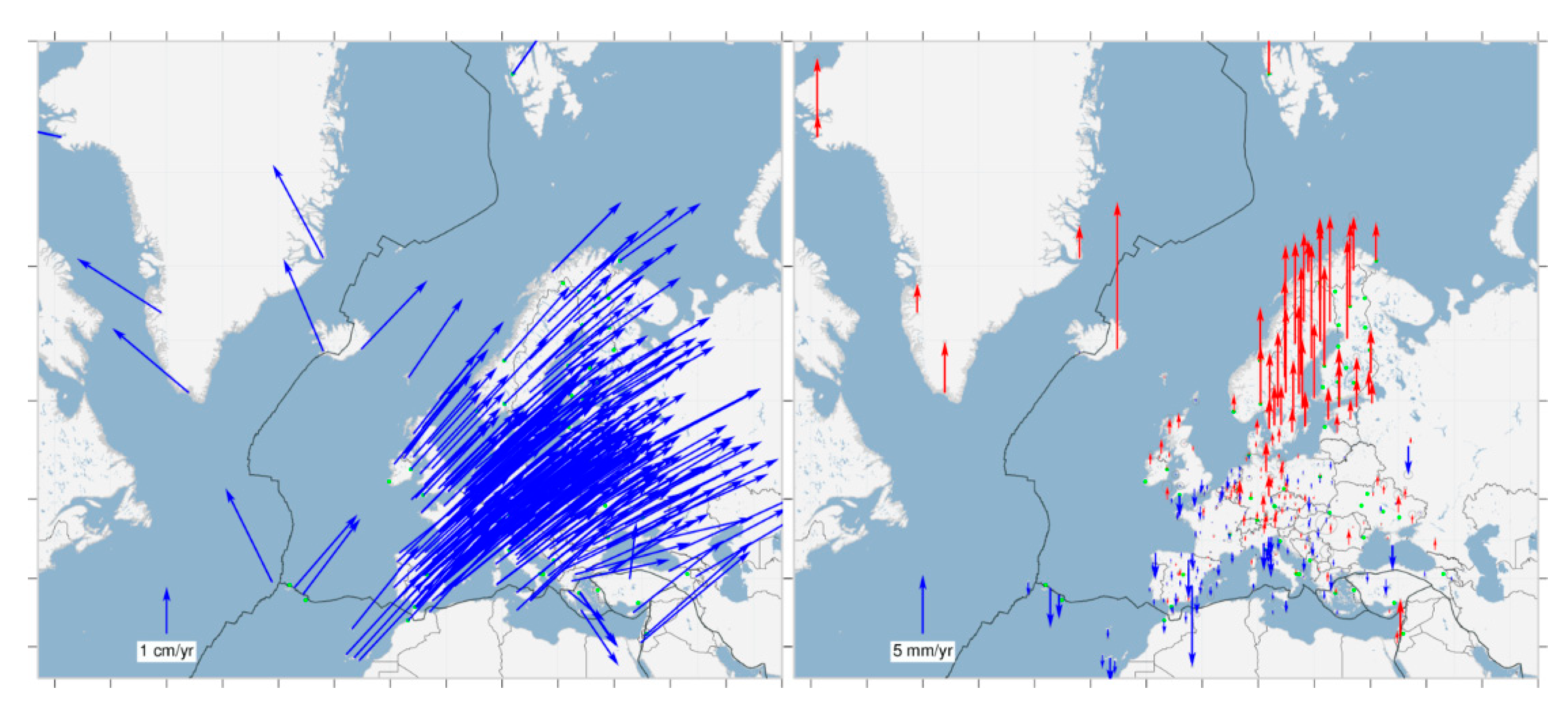
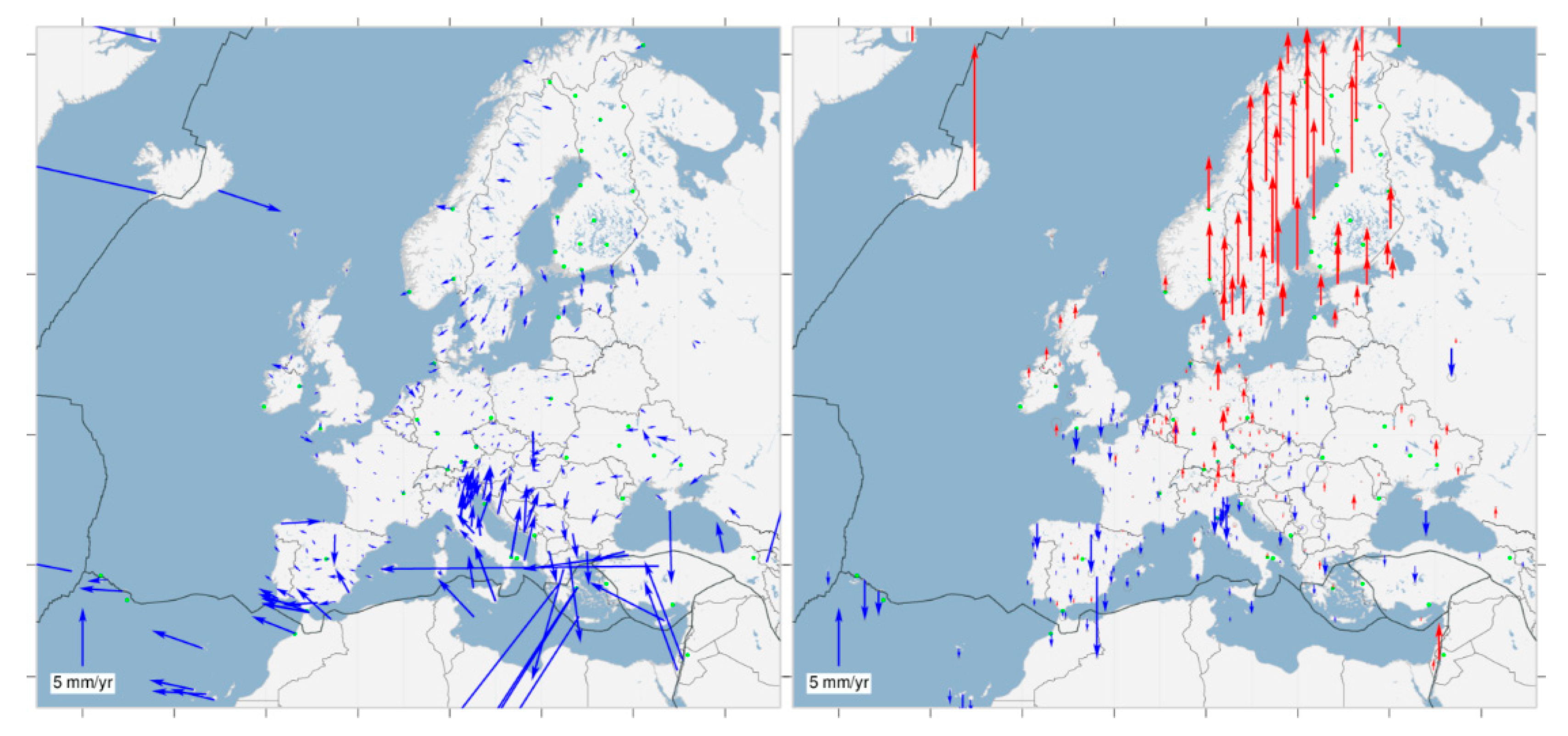

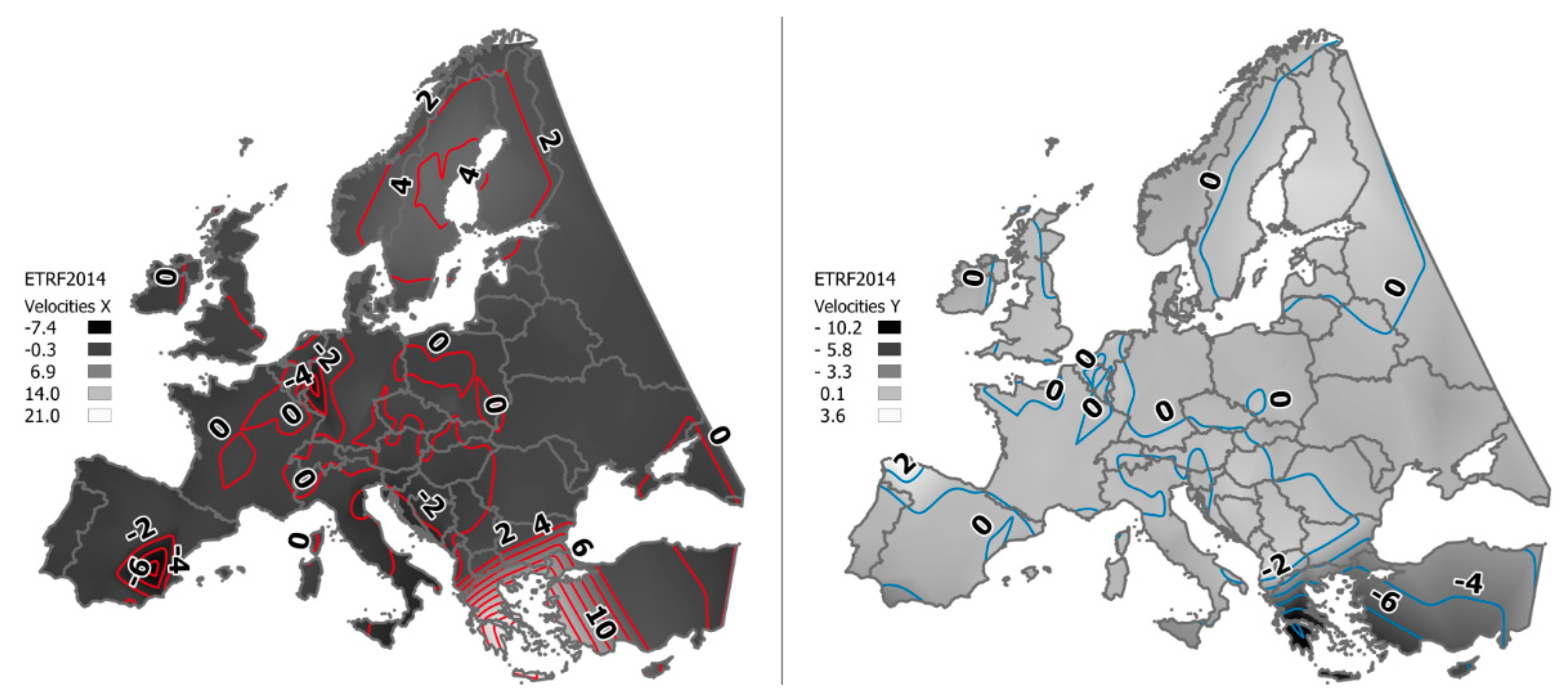
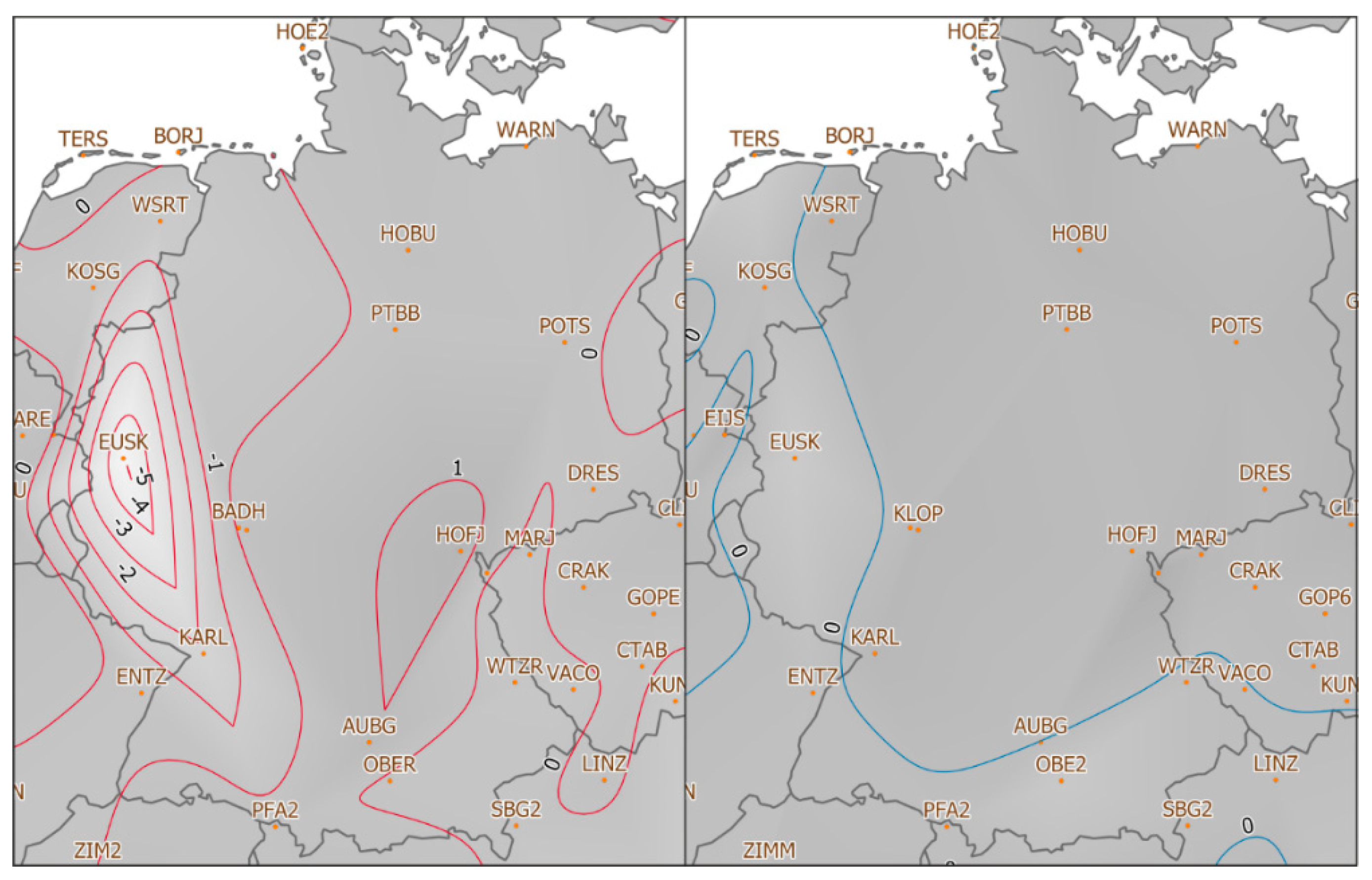
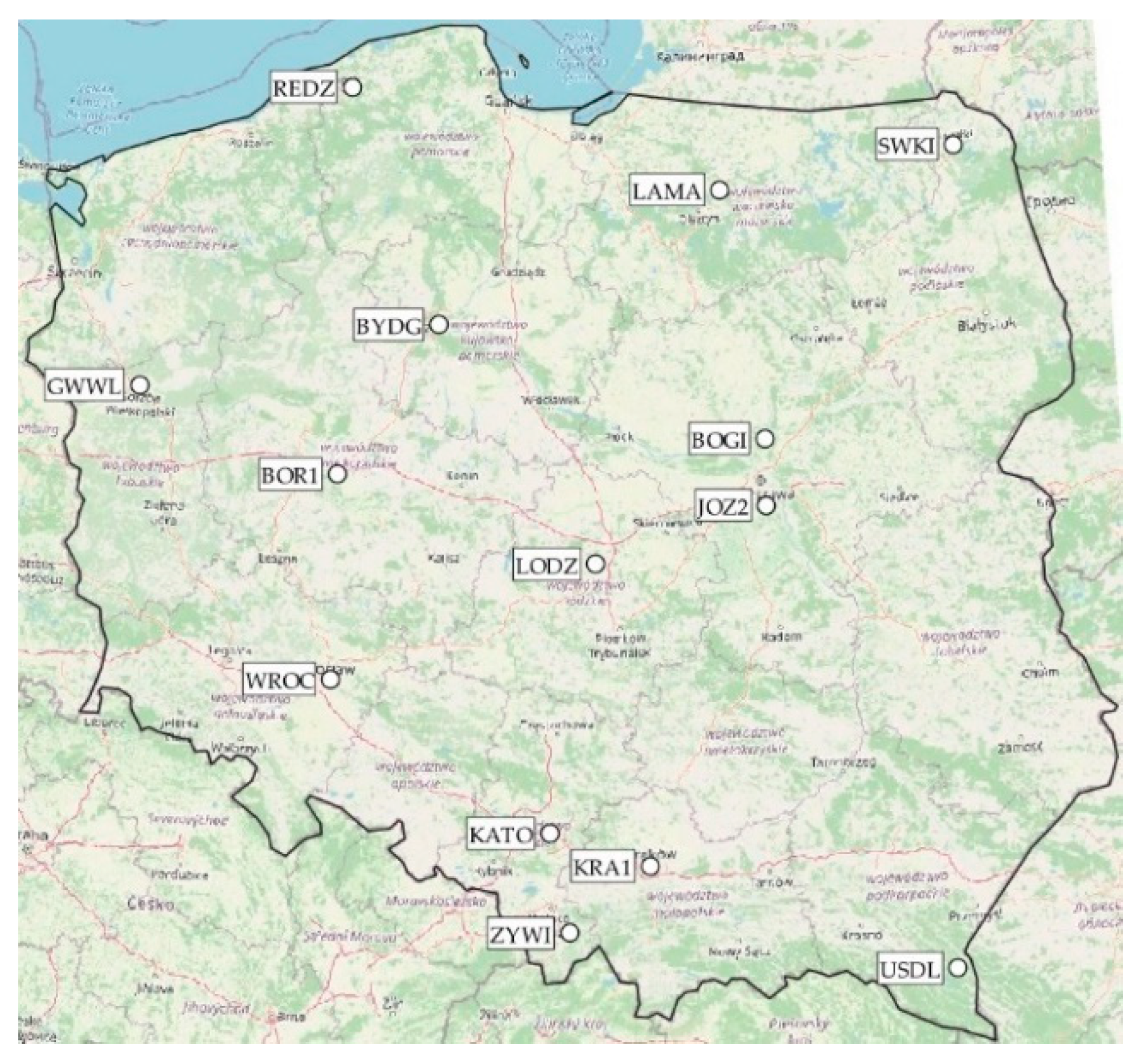
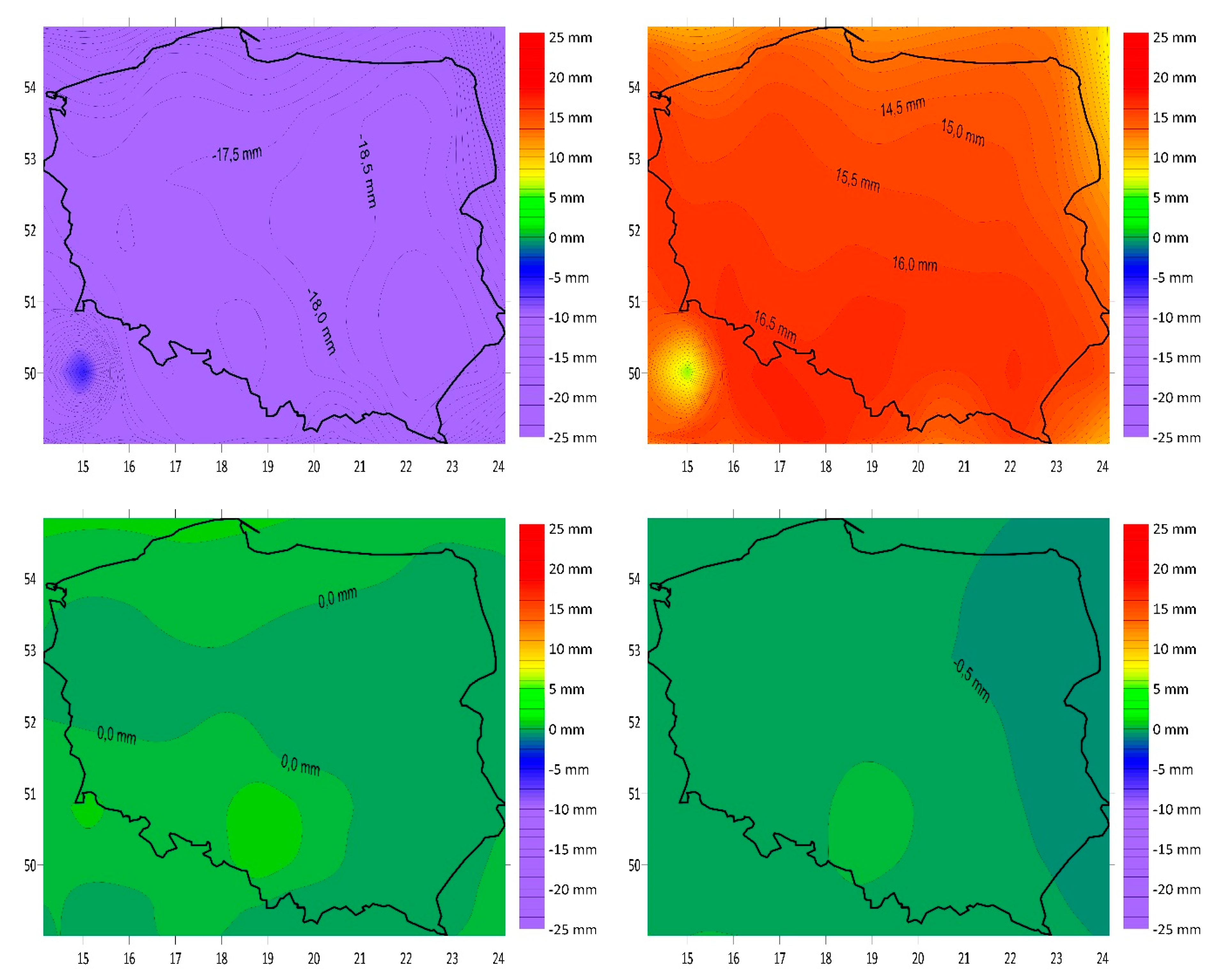
| Station | Vx (mm/year) | Vy (mm/year) |
|---|---|---|
| BISK | 0.1 | −0.2 |
| BOGI | 0.1 | −0.3 |
| BOGO | −0.1 | −0.6 |
| BOR1 | −0.1 | −0.3 |
| BYDG | 0.0 | −0.4 |
| CFRM | 0.2 | −0.1 |
| CLIB | 0.7 | −0.4 |
| CPAR | 0.2 | −0.3 |
| GWWL | −0.5 | −0.5 |
| JOZ2 | 0.0 | −0.3 |
| JOZE | 0.0 | −0.3 |
| KATO | 1.6 | 0.7 |
| KRA1 | 0.2 | −0.2 |
| KUNZ | −0.7 | 0.0 |
| LAMA | 0.0 | −0.4 |
| LODZ | −0.4 | −0.2 |
| REDZ | 0.5 | −0.1 |
| SWKI | −0.2 | −0.9 |
| TUBO | 0.0 | −0.1 |
| USDL | −0.3 | −0.4 |
| WROC | 0.1 | −0.5 |
| ZYWI | −0.3 | −0.4 |
| Reference Frame | Velocity Direction | 10 Years (m) | 25 Years (m) | 50 Years (m) |
|---|---|---|---|---|
| IGS14 | X | 0.19 | 0.48 | 0.95 |
| Y | 0.17 | 0.41 | 0.82 | |
| XY | 0.25 | 0.63 | 1.25 | |
| ETRF2014 | X | 0.05 | 0.13 | 0.25 |
| Y | 0.05 | 0.13 | 0.25 | |
| XY | 0.07 | 0.18 | 0.35 |
Publisher’s Note: MDPI stays neutral with regard to jurisdictional claims in published maps and institutional affiliations. |
© 2021 by the authors. Licensee MDPI, Basel, Switzerland. This article is an open access article distributed under the terms and conditions of the Creative Commons Attribution (CC BY) license (http://creativecommons.org/licenses/by/4.0/).
Share and Cite
Maciuk, K.; Peska-Siwik, A.; El-Mowafy, A.; Borowski, L.; Apollo, M. Crustal Deformation Across and beyond Central Europe and Its Impact on Land Boundaries. Resources 2021, 10, 15. https://doi.org/10.3390/resources10020015
Maciuk K, Peska-Siwik A, El-Mowafy A, Borowski L, Apollo M. Crustal Deformation Across and beyond Central Europe and Its Impact on Land Boundaries. Resources. 2021; 10(2):15. https://doi.org/10.3390/resources10020015
Chicago/Turabian StyleMaciuk, Kamil, Agnieszka Peska-Siwik, Ahmed El-Mowafy, Lukasz Borowski, and Michal Apollo. 2021. "Crustal Deformation Across and beyond Central Europe and Its Impact on Land Boundaries" Resources 10, no. 2: 15. https://doi.org/10.3390/resources10020015
APA StyleMaciuk, K., Peska-Siwik, A., El-Mowafy, A., Borowski, L., & Apollo, M. (2021). Crustal Deformation Across and beyond Central Europe and Its Impact on Land Boundaries. Resources, 10(2), 15. https://doi.org/10.3390/resources10020015





